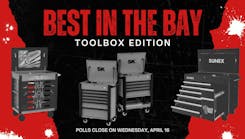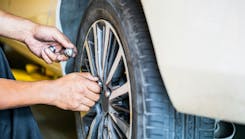Vehicles affected – All
Tools used:
· HVAC Training
· Specific Vehicle Information
· Refrigerant Sealant Detection System
· Refrigerant Identifier
· Recovery/Recycle/Recharge (RRR) Machine
· Scan tool
Once upon a time automotive Heating, Ventilation, Air-Conditioning (HVAC) systems were relatively simple and easy to diagnose and repair with a few simple tools, such as a voltage test light and a set of handheld manifold gauges. Today’s vehicle systems have technologically advanced to the point where just a few tools is not nearly enough to correctly diagnose and repair a system.
Automotive HVAC technology has advanced for a number of reasons, but the primary changes have come about due to requirements for more environmentally friendly refrigerants. This in combination with the desire for smaller systems that put less load on the engine, thereby providing better fuel economy, has necessitated more reliance on the vehicle’s computer systems.
Considering all those factors, there are a few “tools” that are now necessary to work on HVAC systems which weren’t necessary before. First and foremost, EPA 609 Certification is a requirement and failure to hold this certification could bring about astronomical penalties to shops and technicians that are not certified.
The U.S EPA Clean Air Act requires every person working for pay, monetary or barter, to have passed the EPA 609 Certification exam. The test is an open-book format and can be done online. At this point, the certification is good for life, but even if you have held the certification since its inception, it is recommended that technicians take the newest version of the certification test that came out in 2015. The latest version of the certification provides updates on the proper handling of most new refrigerants including R-1234yf.
Holding a 609 certification does not really mean you are knowledgeable enough to diagnose and repair current, or even legacy, HVAC systems. The EPA 609 course, test, and certification revolves around the environmental and legal requirements of working on mobile air conditioning systems and their refrigerants, not the mechanical or electronic operation of the system.
Fines for not complying with certification requirements are just under $40,000 per technician per day. The fine for venting refrigerant to the atmosphere is $25,000. Estimates of non-certified technicians working on A/C systems range from 18 to 60 percent, meaning there is a likelihood that you have non-certified technicians working in your shop and could be facing heavy fines.
Another often-missed part of the EPA Clean Air Act requires that shops servicing air conditioning systems must certify to their regional EPA office that they have acquired and are properly using refrigerant handling equipment. This means that even if you have been performing A/C work for many years, if you have never self-certified with the EPA, you are not in compliance. Once you have certified, you will not need to re-certify if you purchase new equipment. Information about the Clean Air Act, and 609 certification requirements can be found at: epa.gov
Now that I have provided you with a reality check of the legal requirements for working on mobile A/C systems, we should discuss the technical aspects of some of the advanced systems on today’s vehicles. Due to the electronics on these systems, it is necessary to completely understand how a system functions, along with their operating characteristics and capacities. The best way to accomplish this is to attend some advanced training classes, many of which are available through sources such as Motor Age Training which provides online Pay Per View webinars and free YouTube channel videos.
If you work on hybrid or other electric vehicles, you must completely understand the repair procedures and safety protocols prior to working on their HVAC systems. There are some very good online (and prior to COVID-19, in-person) training materials available specific to high voltage HVAC systems, which require unique measures and tools to safely work on these systems.
In order to explain some of the challenges when working on new innovations in A/C systems, consider what is involved in allowing either the air conditioner or defroster/heater to still function when either a hybrid electric, or even a vehicle with start/stop technology is at a stoplight with the engine off for a lengthy period of time.
How do you fully test a vehicle with some of these technologies? You use specific vehicle information in order to determine how the system should function. The first area to look at when obtaining specific vehicle data is the specification area. This will provide you with the type of refrigerant, the type of oil, and the capacities of both.
With today’s systems, it is not OK to assume that every vehicle is the same across a vehicle manufacturer’s complete line, or that what is correct for one tear is the same for another. For example, a 2000 Ford Explorer has a capacity of 30 oz. of R-134. A 2010 Ford Explorer uses 44 oz. of R-134, and a 2020 Explorer uses 34 oz. of R-1234yf. Most technicians would incorrectly assume that a newer vehicle will use a lesser amount of R-134a, but as you see, the newer 2010 uses more refrigerant. Most technicians will also assume that a vehicle uses significantly less R-1234yf, but when you compare the 2000 Explorer to the 2020, you can see the R-1234yf capacity is higher.
In the past, over or under-charging an A/C system by 10-15 percent would not be a big issue, and in most driving conditions the system would function just fine. With many vehicles now using relatively small amounts of refrigerant, some using less than one pound, the refrigerant charge is critical to system performance. There are some systems that will be adversely affected if the system is over- or under-charged by as little as two ounces.
The next most critical tool to use while checking an A/C system is a refrigerant sealant detector. I recently taught a HVAC course at an auto parts store. While I was preparing for the class, I toured the store shelves to determine what type of products they had available for technicians and the DIYer to charge or repair A/C. The thing that surprised me most was that every product they sold had a sealant in the refrigerant charge can. Why this is important is that if you were to recover refrigerant that a DIYer had charged with this product, you would be allowing the sealant to enter your RRR machine where it could cause damage to some of the machine’s components.
In order to prevent this, use a sealant detector. If sealant is detected, either refuse to work on the system, use a filter to remove the sealant, or use an older machine that does not have some of the electronic solenoids that could be damaged during the recovery process.
Along the same lines, a refrigerant identifier should be used to identify the type of refrigerants or whether there are any contaminants in the system. Just a note, if you had your EPA 609 certification, you would be familiar with the need for identifying the refrigerant prior to connecting your machine.
The next “must” tool is your scan tool. It is critical to check for fault codes in the HVAC system. With most vehicles using multiple modules to communicate almost every task, you should also perform a “Health Check”, which checks every module in the vehicle to determine if there are any communication faults. These would appear as a “U” code and should be addressed and corrected prior to any other repairs.
Once electronic system repairs have been performed, and you’ve determined if your machine and refrigerant supply will be safe from contamination, you can connect your RRR machine. Normal system operating pressures can also be found in the vehicle information database. Use your machine to service the system as needed.
If the system is still not functioning normally most vehicle information databases have a trouble shooting guide specific to the vehicle, but you should note that almost all vehicle manufacturers have a recommended Performance Test. This test when followed will both prepare the vehicle in the manner the vehicle manufacturer requires for testing and will provide the technician with information that will be consistent from one test to another during their diagnosis. For example, if you were to test a vehicle on an afternoon that was 95 degrees, the system pressures would not be the same if you tested the same vehicle the next morning when it was 55 degrees outside.
One of the best, quickest, and most accurate test tools I have seen for troublesome HVAC issues are the various analyzers that use a series of wireless pressure transducers and temperature sensors to evaluate and determine the most likely cause of system issues based on various algorithms. These tools calculate superheat and subcool to determine if the system is correctly charged, whether air is present in the charge, and a variety of other problems. These tools can save a technician numerous hours of time spent trying to diagnose either difficult or intermittent issues. As an added bonus, these tools are relatively inexpensive and their ROI is realized after just a few uses.
To sum things up:
· Get certified
· Take some classes on current A/C systems
· Use correct vehicle data
· Make sure the system is not contaminated
· Prepare the vehicle for testing
Once all of these steps are done correctly, you will be in a better position to diagnose and repair HVAC systems more efficiently, and become more profitable.



